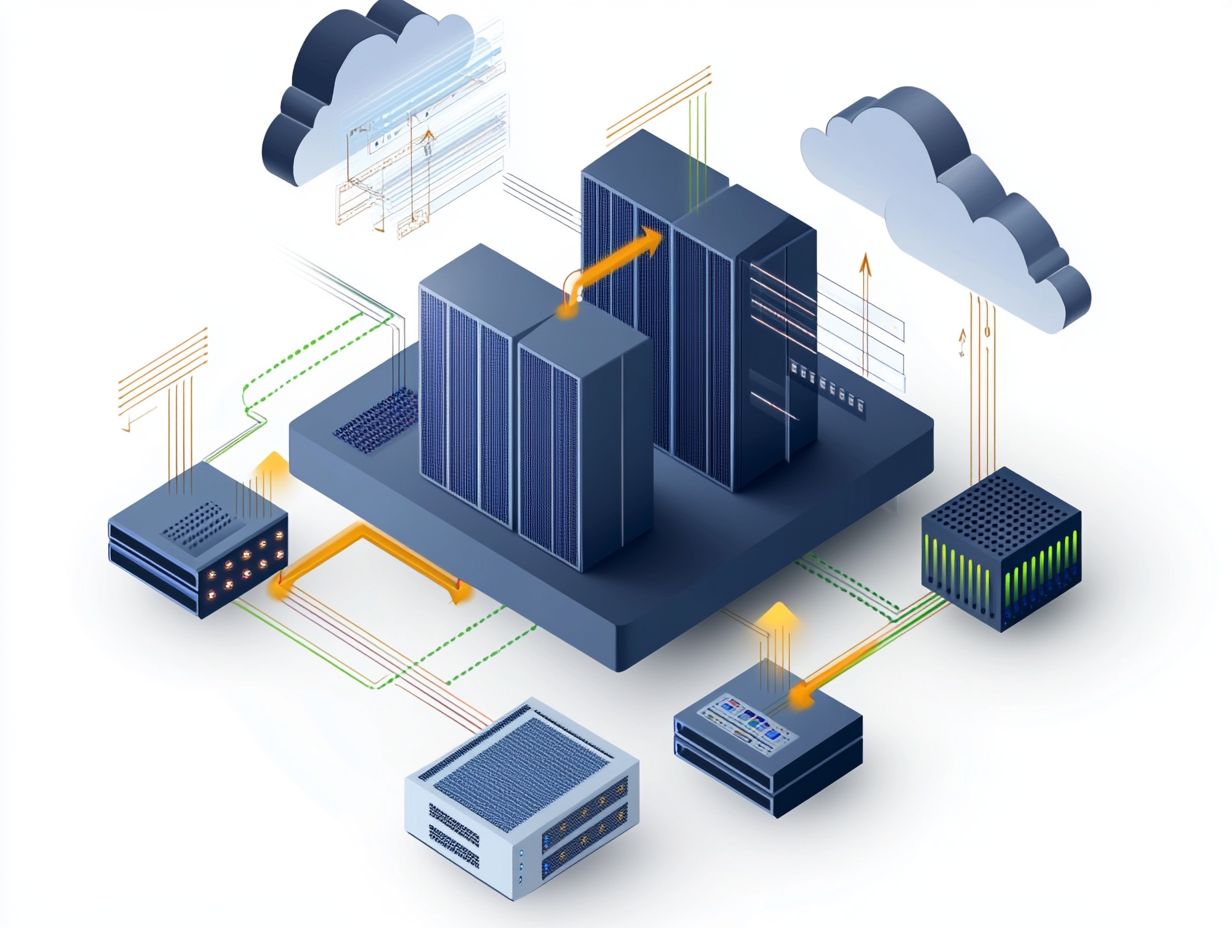How IaaS Supports Hybrid Cloud Environments
In today s rapidly evolving digital landscape, grasping Infrastructure as a Service (IaaS) is crucial for any business aiming to optimize its hybrid cloud environments.
This article delves into the definition and key features of IaaS, showcasing benefits such as scalability, flexibility, and cost efficiency that you won t want to miss.
However, implementing IaaS does come with its own set of challenges, including integration, management, and security concerns that you ll need to navigate.
You ll find best practices for maximizing its potential along with real-world examples that highlight successful IaaS applications.
Explore how IaaS can revolutionize your hybrid cloud strategy! Don t miss out on this opportunity!
Contents
- Key Takeaways:
- Understanding IaaS (Infrastructure as a Service)
- Benefits of IaaS for Hybrid Cloud Environments
- Challenges of Implementing IaaS in Hybrid Cloud
- Best Practices for Utilizing IaaS in Hybrid Cloud
- Real-World Examples of IaaS in Hybrid Cloud
- Frequently Asked Questions
- 1. How does IaaS support hybrid cloud environments?
- 2. What are the key benefits of using IaaS for hybrid cloud environments?
- 3. Can I use Infrastructure as a Service (IaaS) for both private and public cloud environments?
- 4. How does IaaS support workload portability in hybrid cloud environments?
- 5. Are there any challenges with using IaaS in hybrid cloud environments?
- 6. How can I get started with implementing IaaS in my hybrid cloud environment?
Key Takeaways:

IaaS provides scalability and flexibility for hybrid cloud environments, allowing businesses to easily adjust their resources based on demand. By implementing IaaS, businesses can see cost savings and increased efficiency in their hybrid cloud operations. Choosing the right provider and optimizing resource allocation are essential best practices in utilizing IaaS for hybrid cloud.
Understanding IaaS (Infrastructure as a Service)
Infrastructure as a Service (IaaS) is an innovative way to rent and manage virtualized computing resources seamlessly over the internet.
This cloud service model allows access to scalable compute resources, such as virtual machines, storage, and network infrastructure, without the burden of hefty hardware investments.
In the contemporary business environment, where agility and efficiency reign supreme, IaaS equips your organization to swiftly adapt to evolving demands while optimizing operational costs.
Definition and Key Features
IaaS is a sophisticated cloud computing model that provides virtualized computing resources over the internet, allowing your organization to manage its infrastructure without the constraints of physical hardware.
This model enables on-demand virtual machines that can be deployed swiftly and customized to meet specific workloads, facilitating rapid scaling in response to ever-changing demands.
Along with these versatile computing options, IaaS provides flexible storage solutions, enabling you to expand your storage effortlessly as your data requirements evolve.
Enhanced network connectivity ensures seamless integration with your existing systems, while a method that allows you to manage your network through software, making it easier to control and optimize.
The appealing pay-as-you-go pricing model enhances its attractiveness, ensuring you only pay for the resources you actually use. This makes IaaS a cost-effective choice for businesses of all sizes looking to boost efficiency and agility.
Benefits of IaaS for Hybrid Cloud Environments
The integration of IaaS with existing systems into hybrid cloud environments presents you with a wealth of advantages, greatly enhancing your business agility and operational efficiency.
You can scale your infrastructure effortlessly with IaaS to meet changing demands, optimize costs with a flexible payment structure, and establish robust disaster recovery capabilities, meaning your data is safe and can be quickly restored in case of any failures.
This level of adaptability not only supports effective workload management but also encourages a forward-thinking approach to performance monitoring across various applications.
Scalability and Flexibility
One of the key advantages of IaaS in hybrid cloud environments is its exceptional scalability and flexibility, enabling you to adjust your compute resources dynamically based on real-time needs.
This feature is particularly beneficial for organizations like yours that face fluctuating workloads, enabling you to manage demand peaks efficiently without the hassle of over-provisioning resources.
As your operational requirements evolve, the ability to scale up or down ensures that you utilize resources effectively, ultimately minimizing costs.
In this context, integrating performance monitoring tools becomes essential, as they provide valuable insights into resource usage and application performance.
By harnessing data from these tools, you can optimize your resource allocation, ensuring that you maintain high service levels while seamlessly adapting to changing operational demands.
Ready to explore IaaS for your business? Let’s get started today!
Cost Savings and Efficiency

Infrastructure as a Service (IaaS) offers significant cost savings. Its pay-as-you-go model allows you to pay only for the resources you actually consume.
This flexible pricing structure minimizes hefty upfront capital expenses typically associated with traditional infrastructure investments. It enhances your ability to allocate resources effectively. You can easily scale your usage up or down based on real-time needs.
For example, if you’re part of a rapidly growing startup, you can provision additional computing resources during peak project demands. This can be done without the burden of long-term contracts. Embracing cloud solutions gives you the financial agility to pivot your strategies as market conditions shift.
Established enterprises have also seen significant reductions in operational costs by leveraging IaaS for testing and development. Many report savings of up to 30% compared to on-premises solutions.
Adaptive cloud infrastructure can transform your organization s financial efficiency. Don’t miss out on these opportunities!
Challenges of Implementing IaaS in Hybrid Cloud
While IaaS offers a wealth of advantages for Hybrid Cloud solutions, it introduces challenges related to integration and management that you must navigate with care.
Integration and Management
Successful integration and management of IaaS within hybrid cloud environments demand careful planning. Collaborate with a trusted cloud service provider.
This multifaceted approach begins with assessing your existing infrastructure. You need to pinpoint specific workload requirements, ensuring that both your legacy systems and new applications can communicate seamlessly.
By working closely with your chosen cloud provider, you can tap into their expertise to dynamically scale resources. This enhances performance while optimizing cost efficiency.
Implementing robust security protocols is essential. Incorporate strategies like encryption and continuous monitoring to safeguard sensitive data throughout the integration process.
Maintain an ongoing dialogue with your cloud partners. Leverage automation tools to achieve a seamless integration that meets your current demands and adapts to future growth.
Security and Compliance
When implementing IaaS in a Hybrid Cloud environment, security and compliance become top priorities. You need robust strategies to safeguard sensitive data.
Act now! The ever-changing cloud services landscape presents unique challenges you can t afford to ignore. Adhering to industry regulations is essential for protecting customer information.
By implementing centralized security frameworks, you can streamline the necessary protective measures for managing data effectively across different platforms. These frameworks help you monitor compliance with standards like GDPR or HIPAA and enhance your organization’s ability to respond swiftly to potential threats.
Establishing clear policies and continuous auditing processes will aid in mitigating risks. This ensures that you remain vigilant against the rising tide of cyber threats.
Best Practices for Utilizing IaaS in Hybrid Cloud
To fully harness the advantages of IaaS in Hybrid Cloud environments, embrace best practices that facilitate effective resource management and strategic provider selection.
This approach enhances operational efficiency and positions your organization for sustained growth and innovation.
Ready to optimize your cloud strategy? Let s get started!
Choosing the Right Provider

Selecting the right cloud service provider is essential for any organization implementing IaaS within a Hybrid Cloud framework. This choice impacts operational efficiency and the ability to scale resources effectively.
Pay close attention to performance metrics like uptime and latency. These factors directly affect your productivity.
Security features are critical as well. Look for data encryption and compliance with regulations like GDPR or HIPAA to protect sensitive information.
Compare top providers like AWS, Azure, and Google Cloud to find the best fit for your needs. Each has unique advantages in pricing, support, and global reach.
Optimizing Resource Allocation
Optimizing resource allocation in IaaS deployments is crucial to achieving the performance levels and cost efficiencies you seek in Hybrid Cloud environments.
To enhance this optimization, leverage advanced performance monitoring tools. These tools offer real-time insights into resource utilization and application responsiveness.
Implement workload management strategies that adjust resource allocation based on demand. This ensures that your cloud solutions are utilized effectively.
For example, auto-scaling adjusts resources automatically based on demand, while load balancing distributes workloads evenly. These features help maintain optimal performance while minimizing costs.
Adopt these strategies now to boost your efficiency and drive innovation!
Real-World Examples of IaaS in Hybrid Cloud
Real-world examples of IaaS implementations in Hybrid Cloud environments vividly demonstrate how cloud solutions can propel business innovation and enhance operational efficiency.
By leveraging these technologies, you can unlock new opportunities and streamline processes, positioning your organization for success in an increasingly competitive landscape.
Case Studies and Success Stories
Examining case studies and success stories reveals best practices from organizations utilizing IaaS within Hybrid Cloud frameworks.
For instance, a prominent financial institution effectively integrated IaaS solutions from leading providers like AWS and Microsoft Azure. This strategic move enhanced scalability while upholding rigorous security measures.
By harnessing virtualization technology, you can achieve significant cost savings and optimize resource allocation. A retail giant embraced a hybrid approach, enabling them to easily manage peak seasons and unexpected surges in customer demand.
These organizations reported greater operational efficiency and improved agility in responding to market changes, highlighting the tangible benefits of this integration.
Frequently Asked Questions
1. How does IaaS support hybrid cloud environments?

IaaS, which means Infrastructure as a Service, is a cloud computing model that provides virtualized computing resources over the internet. It supports hybrid cloud environments by allowing organizations to integrate their on-premises infrastructure with public cloud services. This enables businesses to have a seamless and flexible IT infrastructure that can scale up or down as needed.
2. What are the key benefits of using IaaS for hybrid cloud environments?
One of the main benefits of IaaS in a hybrid cloud environment is the ability to reduce operational costs. By leveraging public cloud services, organizations can lower hardware and maintenance costs while still using their existing on-premises infrastructure.
Additionally, IaaS offers scalability, flexibility, and improved resource utilization, making it ideal for hybrid cloud environments.
3. Can I use Infrastructure as a Service (IaaS) for both private and public cloud environments?
Yes, IaaS works for both private and public clouds. Private clouds handle sensitive data, while public clouds support less critical workloads.
4. How does IaaS support workload portability in hybrid cloud environments?
IaaS allows businesses to move workloads easily between on-premises servers and public clouds. This flexibility gives companies control over their most cost-effective options.
5. Are there any challenges with using IaaS in hybrid cloud environments?
IaaS has great benefits, but some challenges exist. Organizations may face issues like managing multiple providers and ensuring compatibility between systems.
6. How can I get started with implementing IaaS in my hybrid cloud environment?
Start your IaaS journey now! First, assess your IT infrastructure and pinpoint which workloads fit a hybrid approach.
Next, research IaaS providers that align with your needs. Create a solid plan, focusing on security, cost, and compatibility.






